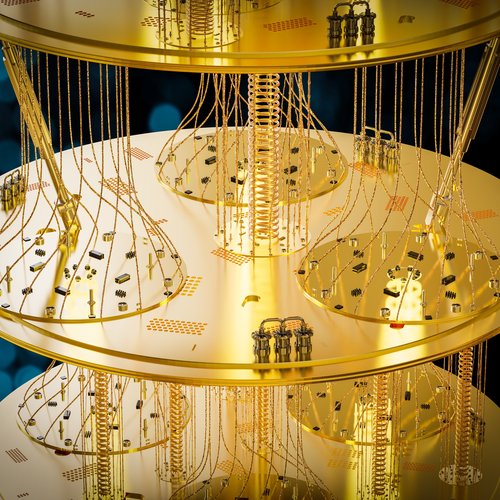Quantum Information Science
Then: Pie in the Sky
Now: Transforming Science and Industry

3D rendering of a quantum computer. (Courtesy: Shutterstock)
From medicine to cybersecurity to electronics, quantum technology enhances various aspects of our everyday experiences. For instance, smartphones, computers and tablets rely on semiconductors, which are based on quantum mechanics. In recognition of the transformative effect quantum technology has had on our world, the United Nations designated 2025 as the International Year of Quantum Science and Technology.
Over the past 25 years, advancements in quantum information science have revolutionized problem-solving and data security, significantly accelerated research and development, and opened new avenues for innovation. Alexander Maloney (AM), the Kathy and Stan Walters Endowed Professor of Quantum Science and director of the Institute for Quantum and Information Science in the College of Arts and Sciences (A&S), and Simon Catterall (SC), professor and associate chair of physics in A&S, discuss the evolution of quantum technology and its potential to revolutionize the future.
What is quantum information science?
SC: Quantum information science combines quantum mechanics with information theory to process, analyze and transmit information. The field took off in the 1990s when Peter Shor, of IBM, showed that quantum computers could factor prime numbers much faster than classical computers. There are now algorithms capable of faster database searches than ever before.
What is the biggest breakthrough in quantum in recent years?
AM: A pivotal innovation is a series of experimental demonstrations resulting in quantum computing devices that operate with surprisingly small error rates. Every computing device, from your phone to a quantum computer, will make errors occasionally. Scientists have been able to reduce these errors rates in a variety of different platforms, turning the study of quantum computers from a “pie in the sky” dream a few decades ago, into a field of research of crucial scientific and societal importance.
Can we expect to see quantum computers become commonplace?
SC: Quantum computers have improved dramatically, going from machines with two physical qubits to hundreds of qubits and tens of logical qubits. Qubit is short for quantum bit, a much more powerful version of bits found in basic computers.
In the next 25 years, I would imagine that quantum computers will have “solved” many of the hard problems in physics and chemistry - those with large numbers of strongly interacting and entangled quantum particles that are too hard for classical computers. But I doubt you will have a quantum computer in your back pocket and why would you – they are not needed for everyday personal use. Classical computers are just fine for doing your taxes and ordering pizza online. Indeed, quantum computers are likely to be specialized machines with narrow but important functions.
How will Syracuse University play a role in quantum information science discoveries over the next 25 years?
AM: We are currently building a strong quantum group at Syracuse, which includes both experimental and theoretical components. Experimentally, we will have several researchers working on various aspects of superconducting devices physics, with important applications to quantum information processing as well as fundamental science. Theoretically, one of the most exciting ideas we are working on is the core fundamental question of how we can understand physical systems - ranging from quantum materials to black holes - in terms of their ability to process and encode information.
SC: Syracuse has a national reputation as a leader in superconducting qubit research and the plan is to strengthen and broaden this with new hires over the next few years. The commitment that the University has made to invest in this field will pay off with increased national and international recognition for Syracuse. I expect us to become a magnet for students and postdocs in this field over the coming years and to play a prominent role in what is likely to become a driving new area of science and engineering in the coming decades.









